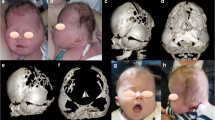Abstract
Crouzon disease is a form of craniosynostosis with the autosomal dominant mode of inheritance. Among the anomalies associated with craniosynostosis, aberrant dural sinus is well known. We report on identical twin sisters with Crouzon disease and sinus pericranii who were successfully treated surgically. In one of the sisters hydrocephalus was present, which eventually needed a shunt operation. The association of these anomalies is discussed.
Similar content being viewed by others
References
Anderson B, Woodhall B (1953) Visual loss in primary skull deformities. Trans Am Acad Ophthal Otolaryng 57:497–516
Bressers WMA, Eriksson AW, Kostense PJ, Parisi P (1987) Increasing trend in the monozygotic twinning rate. Acta Genet Med Gemellol (Roma) 36:397–408
Giuffrè R, Vagnozzi R, Savino S (1978) Infantile craniosynostosis: clinical, radiological, and surgical considerations based on 100 surgically treated cases. Acta Neurochir (Wien) 44:49–67
Golabi M, Edwards MSB, Ousterhout DK (1987) Craniosynostosis and hydrocephalus. Neurosurgery 21:33–63
Hahn EV (1928) Sinus pericranii (reducible blood tumor of the cranium): its origin and its relation to hemangioma and abnormal arteriovenous communication: report of a case. Arch Surg 16:31–43
Hanieh A, Sheen R, David DJ (1989) Hydrocephalus in Crouzon's syndrome. Child's Nerv Syst 5:188–189
Loffredo A, Sammartino A, Crecchio G de (1977) Crouzon disease in twins. Ophthalmologica 175:297–304
Mastin WM (1886) Venous blood tumors of the cranium in communication with the intracranial venous circulation, especially the sinuses of the dura mater. JAMA 7:309–320
Noetzel MJ, Marsh JL, Palkes H, Gado M (1985) Hydrocephalus and mental retardation in craniosynostosis. J Pediatr 107:885–892
Perrin JCS, Weiss MH, Yashon D (1971) Surgical treatment of craniofacial dysostosis in monozygotic twins. J Neurosurg 34:779–782
Rose C, LaConbe J, Kahn A, Renier D, Hirsch J (1984) Intracranial venous sinus hypertension: cause or consequence of hydrocephalus in infants. J Neurosurg 60:727–736
Sawamura Y, Abe H, Sugimoto S, Tashiro K, Nakamura N, Gotoh S, Takamura H (1987) Histological classification and therapeutic problems of sinus pericranii. Neurol Med Chir (Tokyo) 27:762–768
Stromeyer G (1850) Ueber Sinus pericranii. Dtsch Klin 13:160–161
Author information
Authors and Affiliations
Rights and permissions
About this article
Cite this article
Yasuda, S., Enomoto, T., Yamada, Y. et al. Crouzon disease associated with sinus pericranii: a report on identical twin sisters. Child's Nerv Syst 9, 119–122 (1993). https://doi.org/10.1007/BF00305324
Received:
Issue Date:
DOI: https://doi.org/10.1007/BF00305324




